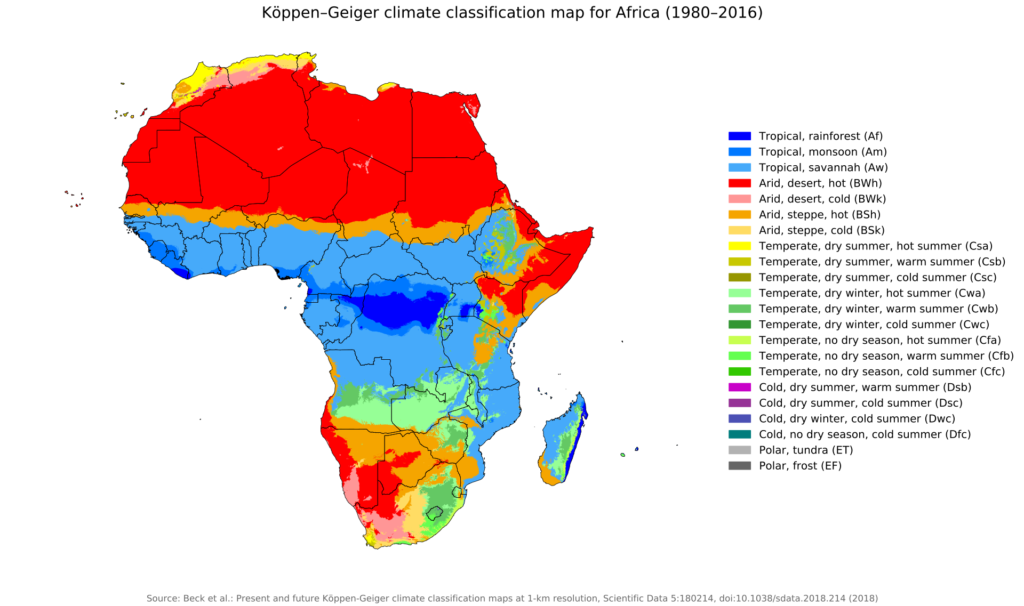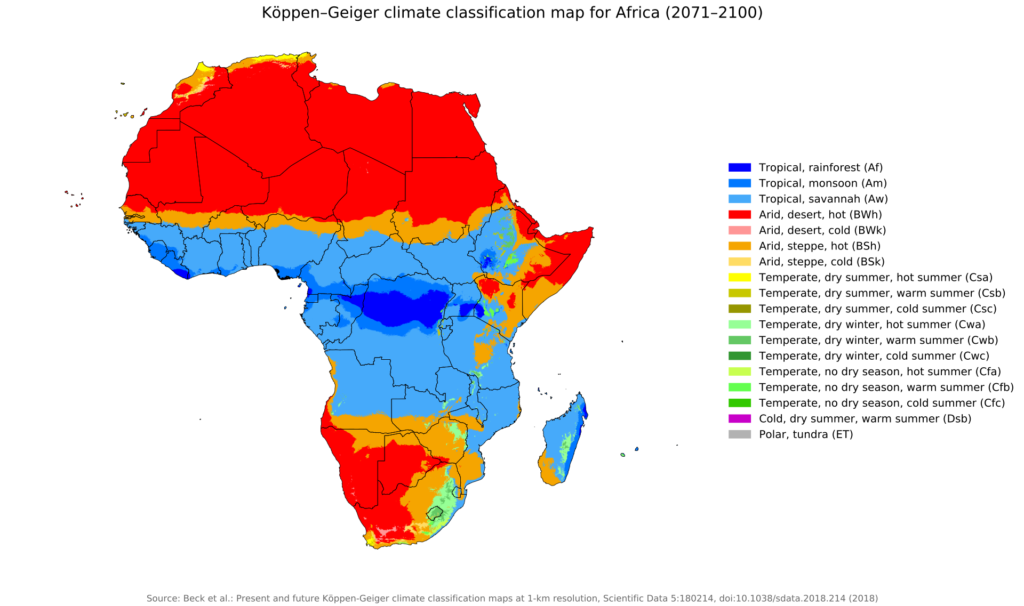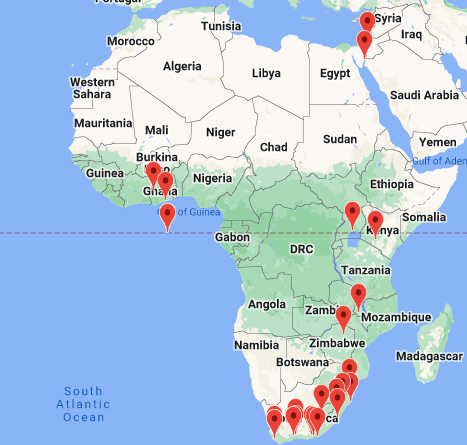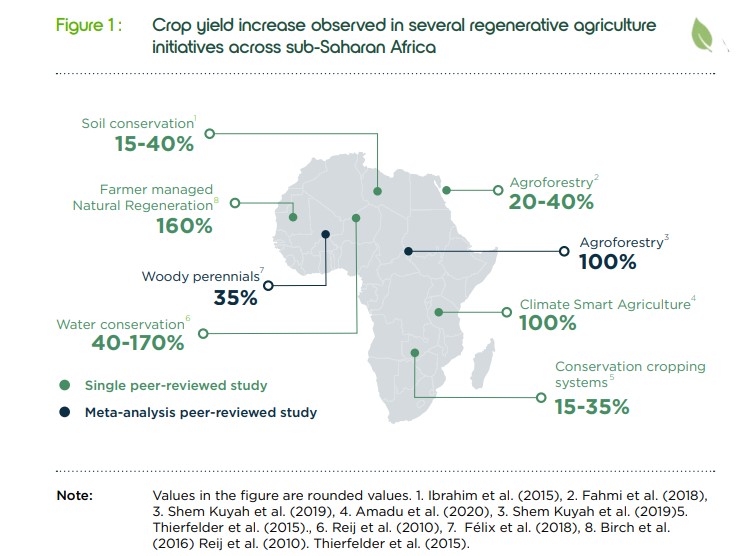Regenerative agriculture (RA), broadly defined, is the practice of any agricultural activity, such as farming or ranching, that improves the environment at the same time as producing food or other farming products.
There are regenerative farms all over the world, although each regenerative farm may use slightly different regenerative practices. This article will explain the benefits of regenerative agriculture in Africa and will present several examples of regenerative agriculture happening in Africa.
Background information: What Is Regenerative Agriculture?
Table of Contents
Why Is Regenerative Agriculture Needed in Africa?
Regenerative Agriculture in Africa
Why Is Regenerative Agriculture Needed in Africa?
Africa is a large continent with a wide variety of climates and types of agriculture. For example, while some of the country is made up of desert, such as the Sahara and the Kalahari, other areas are more similar to tropical climates or Mediterranean climates, such as Morocco’s climate. This huge variation in climates across the continent leads to differing agricultural practices across the continent, and even within countries. No matter the type of farming, agriculture is a major contributor to the African economy, with around 70% of Africans making a living in the agricultural sector.

Source: FAO
Despite this diversity in farming systems (see the map above), many farmers share similar concerns about producing enough food to make a profit, to feed themselves, and to feed the country as a whole. Agricultural challenges in Africa, including low soil health, limited water, climate change, and population growth, are incentivizing farmers to switch from traditional to regenerative agricultural methods.
Low soil health and fertility: Much of African soil is nutrient poor, which can make growing large amounts of crops difficult, and limits the amount of land that can be used for agricultural purposes. For example, around 55% of Africa’s land cannot support any farming except nomadic grazing, and only about 16% of Africa’s land is considered to have high soil quality. Regenerative agriculture in Africa can help increase soil health and fertility. For example, planting cover crops, other plants grown amongst the cash crop, can increase soil health, biodiversity, and water retention while limiting soil erosion.
Limited water and precipitation: The amount of rain in Africa is very location dependent. While some countries do get rainfall, such as Uganda, other areas receive far less water, making it difficult to consistently grow crops, especially crops that require high amounts of water. Regenerative agriculture such as new irrigation practices can help farmers adapt to growing with less water. Many regenerative practices also allow the soil to hold more water, making it possible to increase crop yields with smaller amounts of water.
Climate change: As climate change worsens, Africa is increasingly experiencing its negative impacts, including less precipitation and more extreme climate events like drought.
Agriculture in Africa is especially suffering the consequences of climate change. For example, a study of households in six Sub-Saharan countries shows that 60% of households reported sudden losses in income, in part due to weather events. In fact, some estimates argue that by 2030, over 118 million poor people in Africa, many of whom rely on farming to make a living, will experience drought, floods, and extreme heat.
The map below shows predicted climate changes in Africa for 2071-2100, compared to current conditions. Many areas that are considered temperate currently (shown in green) will not exist and thus will likely be unable to support farming as we know it now.

Source: Beck et al. 2018

Source: Beck et al. 2018
Regenerative agriculture can not only help farmers adapt to climate change’s conditions, but it can even help mitigate climate change by increasing carbon sequestration. Regenerative agriculture will be a crucial tool in helping prevent the worst of climate change, and will also aid farmers in growing in increasingly dry conditions.
Read more: Low Carbon Agriculture
Population growth: As Africa’s population increases and as the amount of arable land decreases due to climate change and desertification, many researchers are concerned that the country will not be able to produce enough food to support everyone. Regenerative agriculture in Africa can help produce more food on smaller areas of land, as RA can help increase crop yields. Regenerative agriculture can also help to prevent more land from being degraded in order to maintain enough land to sustain agriculture.
Regenerative Agriculture in Africa
Regenerative agriculture is happening in Africa in a number of ways, including on farms, as the subject of research, and through NGO projects. Here are a few examples of how regenerative agriculture is playing a role in African farming.
Farming
Agroforestry in Africa
Agroforestry, or the regenerative agriculture practice of planting trees around or among crops, helps increase soil sequestration of carbon (which fights climate change), reduce soil erosion, and increase biodiversity through the creation of new habitats. Many farms in Africa plant trees on their farms, which can provide climate resilience and regenerative benefits as well as fruit and wood that can be sold for profit. For example, a World Bank report shows that among households that grow trees, trees provide 17% of total income.
Boomplaats
Boomplaats is a regenerative farm in South Africa that produces organic food and grass-fed beef. They focus on ensuring healthy soil that is rich in bacteria, and they raise their cattle using rotational grazing. Rotational grazing is a regenerative farming practice in which cattle graze in a specific area while other land is given time to rest and regenerate. This maintains soil health and fertility, which ultimately can increase crop yields.
Other Farms
There are several other regenerative farms in Africa. You can find them using Regeneration International’s regenerative farm map, although there are many farms using regenerative practices that are not shown on this map.

Source: Regenerative Farm Map, Regeneration International
Research
A 2021 report from the Africa Regenerative Agriculture Study Group shows the many positive impacts of regenerative agriculture in Africa. The study found that regenerative practices such as crop diversification, agroforestry, low-tillage farming and water conservation can create benefits such as:
- Increased crop yields: By 2040, regenerative agriculture could increase crop yields by 24%.
- Increased soil health:
- Reduced soil erosion: By 2040, regenerative agriculture could reduce soil erosion by 30%.
- Increased water retention
- Carbon sequestration: By 2040, regenerative agriculture could increase soil organic carbon by 20%.
- Increased biodiversity
- Reduced risks from climate change
The image below shows the increase in crop yields as a result of different types of regenerative agriculture practices. These numbers are derived from several studies on regenerative agriculture in Africa throughout the years, noted below the figure.

The study also argues that increasing the amount of regenerative agriculture happening in Africa could create 5 million jobs by 2040, increase farmers’ revenue, and reduce food insecurity.
NGO Projects
Grounded
Grounded is a South Africa-based nonprofit organization that works to help farms in Sub-Saharan Africa become regenerative. The organization partners with farmers to sell their regenerative products for a fair price, often with a profit-sharing model in which farmers receive extra income when their product does well. In addition to helping farmers implement regenerative agriculture and sell products, Grounded offers farmers aid in product development, international marketing, certifications, and logistics.
Alliance for a Green Revolution in Africa (AGRA)
AGRA is an organization founded by the Bill and Melinda Gates Foundation and the Rockefeller Foundation. Established in 2006, AGRA aimed to increase crop yields and profits for small farmers in Africa by 2021. It’s important to note that while AGRA is a major voice in the sphere of green agriculture in Africa, the organization is not specifically focused on regenerative agriculture (although some of its “interventions” include regenerative tools). Some of AGRA’s main focuses include building climate resilience among farmers impacted by climate change, providing “input” tools to improve seeds and fertilizer use, as well as policy initiatives.
AGRA has been heavily criticized for failing to reach its goals of improving profits and crop yields, as well as for failing to include self-evaluation as part of its system. For example, while AGRA did increase maize yield in three countries (Ethiopia, Ghana and Nigeria), the organization failed to meet this key goal in the other three focus countries (Tanzania, Burkina Faso and Kenya). Additionally, in several countries, even increased crop yields did not lead to increased profits for farmers. Finally, additional critique argues that AGRA failed to include the input of Africans when developing its strategies.